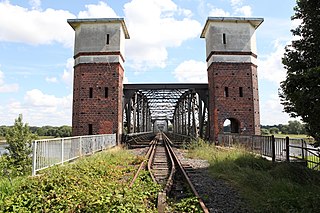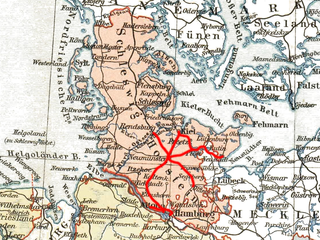
The Baghdad railway, also known as the Berlin–Baghdad railway, was initially started in 1903 but was not completed until 1940 to connect Berlin with the then Ottoman city of Baghdad, from where the Germans wanted to establish a port on the Persian Gulf, with a 1,600-kilometre (1,000 mi) line through modern-day Turkey, Syria, and Iraq.

Tawang is a town in the Indian state of Arunachal Pradesh.

The Battle of China (1944) was the sixth film of Frank Capra's Why We Fight propaganda film series.

China National Highway 219 is a highway which runs along the entire western and southern border of the People's Republic of China, from Kom-Kanas Mongolian ethnic township in Xinjiang to Dongxing in Guangxi. At over 10,000 kilometres (6,214 mi) long, it is part of the China National Highway Network Planning (2013–2030), and once completed it will be the longest National Highway.
The history of rail transport in China began in the late nineteenth century during the Qing dynasty. Since then, it has become one of the largest rail networks in the world.

The Sino-Indian border dispute is an ongoing territorial dispute over the sovereignty of two relatively large, and several smaller, separated pieces of territory between China and India. The first of the territories, Aksai Chin, is administered by China as part of the Xinjiang Uygur Autonomous Region and Tibet Autonomous Region and claimed by India as part of the union territory of Ladakh; it is the most uninhabited high-altitude wasteland in the larger regions of Kashmir and Tibet and is crossed by the Xinjiang-Tibet Highway, but with some significant pasture lands at the margins. The other disputed territory is south of the McMahon Line, formerly known as the North-East Frontier Agency and now called Arunachal Pradesh. The McMahon Line was part of the 1914 Simla Convention signed between British India and Tibet, without China's agreement. China disowns the agreement, stating that Tibet was never independent when it signed the Simla Convention.

The military use of railways derives from their ability to move troops or materiel rapidly and, less usually, on their use as a platform for military systems, like very large railroad guns and armoured trains, in their own right. Railways have been employed for military purposes in wartime since the Revolutions of 1848. Improvements in other forms of transport have rendered railways less important to the military since the end of World War II and the Cold War, although they are still employed for the transport of armoured vehicles to and from exercises or the mass transport of vehicles to a theatre of operations. The US Air Force developed the Peacekeeper Rail Garrison mobile ICBM in the 1980s, but it never reached operational status.

The transport infrastructure of Yunnan is served by numerous transport modes, and forms an integral part of the structure Yunnan Province and the Southwest of China. Yunnan is served by several civilian airports and a major highway and rail network. The province is served by a network of bus routes that radiates from the capital city, Kunming.

The Main–Weser Railway is a railway line in central Germany that runs from Frankfurt am Main via Gießen to Kassel. it is named after the railway company that built the line and also operated it until 1880. It was opened between 1849 and 1852 and was one of the first railways in Germany.

Treysa station is a train station in Schwalmstadt, Hesse, on the Main–Weser Railway. It was formerly a railway junction, connecting to the Leinefelde–Treysa section of the Cannons Railway.

The Biederitz–Trebnitz railway is a double-tracked, standard gauge, electrified railway line in the German state of Saxony-Anhalt timetabled as (KBS) 254 and 256. The line begins in Biederitz near Magdeburg and runs via Güterglück towards Dessau. According to Deutsche Bahn, the line ends at Trebnitz on the former border between the Duchy of Anhalt and Prussia.

The Berlin-Blankenheim railway or Wetzlarer Bahn is a railway line in the German states of Berlin, Brandenburg and Saxony-Anhalt. It is a section of the Kanonenbahn between Berlin and Metz, built between 1877 and 1882. Wetzlar used to be an important rail junction on the Kanonenbahn. The Berlin-Blankenheim line originally ran from Berlin, via Bad Belzig, Güsten, Sandersleben to Blankenheim, where a remnant of it still joins the Halle–Kassel line. The Wiesenburg–Güsten section has carried no traffic since 2004 and is now closed. Only the Berlin–Wiesenburg section is electrified. The Sandersleben–Blankenheim section has only a single track, while the remainder of the still-operating parts of the line is duplicated.

The Göttingen–Bebra railway is a mainline railway in Germany, running north–south, which mainly serves through traffic. It is part of the old North–South railway and until 1991 Intercity trains ran on it. Today it is used mainly by freight trains, as well as regional and night passenger trains.

The Altona-Kiel Railway Company was a joint-stock company, established under the law of Denmark in personal union with the Duchy of Holstein, that built and operated an 105 km railway line between Altona and the Baltic Sea port city of Kiel. Altona was at that time the second largest city under Danish rule and the railway line was the first built in Danish-controlled territory.

The Wiesenburg–Roßlau railway is a two-track main line in the German states of Brandenburg and Saxony-Anhalt. It is part of a line connecting Berlin and Halle / Leipzig via Dessau.

The Kanonenbahn is a former German military strategic railway between Berlin and Metz via Güsten, Wetzlar, Koblenz and Trier. Metz is in Alsace-Lorraine, which was annexed by Germany after the Franco-Prussian War.

The Lollar–Wetzlar railway was a railway line in the German state of Hesse, connecting the towns of Lollar and Wetzlar via Lahnau. It was opened in 1878 as part of the Cannons Railway (Kanonenbahn) from Berlin to Metz, but was closed in 1983.
The Berlin Outer Freight Ring was a planned ring railway around the city of Berlin, Germany. The first sections of a line to the west of the city were built in the early 20th century as part of the Brandenburg Bypass Railway (Umgehungsbahn). Even then, there were plans for a bypass south of Berlin. The first bits were built in the early 1920 and more sections followed in the 1930s. The line could not be completed due to the impact of the Second World War. The completed section consisted of a mainly single-track link running from Teltow to Berlin-Karow to the south and east of Berlin. Part of the route line later became part of the Berlin outer ring.
The Royal Prussian Military Railway, also called the Königliche Militär-Eisenbahn, was a Prussian state railway, operated by the army, between Schöneberg and Kummersdorf, later extended to Jüterbog.

Ehrang station is, after Trier Hauptbahnhof, the second most important station in the city of Trier in the German state of Rhineland-Palatinate. The station forms a railway junction with a former marshalling yard that is still partly used as a freight yard. At the station, the Eifel Railway from Cologne connects with the Koblenz–Trier railway. Until 1983, Ehrang station was also the starting point of the Trier West Railway to Igel that connected with Wasserbillig / Luxembourg.

















